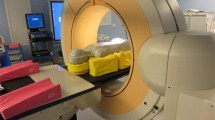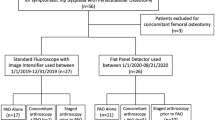Abstract
The objective of this study was to directly measure the radiation exposure to the orthopaedic surgeon and to measure dose points to the surgeon’s fingers, thyroid gland, and forehead during intraoperative fluoroscopy in periacetabular osteotomy (PAO). In a series of 23 consecutive periacetabular osteotomy procedures, exposure monitoring was carried out using thermo luminescent dosimeters. The effective dose received by the operating surgeon was 0.008 mSv per operation which adds up to a yearly dose of 0.64 mSv from PAO. The median point equivalent dose (mSv) exposure under PAO was 0.009 for the forehead and thyroid gland, 0.045 for the right index finger, and 0.039 for the left index finger. The effective estimated yearly dose received by the operating surgeon was very low. Wearing a lead collar reduces radiation exposure to the thyroid gland while the lead gloves did not protect the surgeon’s fingers.
Résumé
L’objectif de cette étude est de mesurer l’exposition aux rayons X au niveau des mains et de la thyroïde des chirurgiens orthopédistes après utilisation de l’amplificateur de brillance au cours d’une ostéotomie périacétabulaire. Matériel et méthode: une série de 23 ostéotomies pericétabulaires a été réalisée en utilisant l’ampli. Résultat: la dose effective reçue par le chirurgien était de 0,008 mSv par intervention et doit s’additionner avec la dose de 0,64 mSv du fait de l’ostéotomie péri acétabulaire. La dose moyenne d’exposition était de 0,009 pour le tronc et la glande thyroïde, de 0,045 pour l’index droit et de 0,039 pour l’index gauche. En conclusion: les doses reçues par le chirurgien sont très basses. Le port d’un collier de protection permet de diminuer les radiations au niveau de la thyroïde et l’utilisation de gants de plomb ne permet pas de protéger les mains des chirurgiens.


Similar content being viewed by others
References
International Commission on Radiological Protection (1999) Risk estimation for multifactorial diseases. A report of the International Commission on Radiological Protection. Ann ICRP 29:1–144
Alonso JA, Shaw DL, Maxwell A, McGill GP, Hart GC (2001) Scattered radiation during fixation of hip fractures. Is distance alone enough protection? J Bone Joint Surg Br 83:815–818
Blattert TR, Fill UA, Kunz E, Panzer W, Weckbach A, Regulla DF (2004) Skill dependence of radiation exposure for the orthopaedic surgeon during interlocking nailing of long-bone shaft fractures: a clinical study. Arch Orthop Trauma Surg 124:659–664
Clarke RH (2000) Issues in the control of low-level radiation exposure. Med Confl Surviv 16:411–422
Clarke RH (2003) Radiological protection philosophy for the 21st century. Radiat Prot Dosimetry 105:25–28
Clarke RH, Stather JW (1993) Implementation of the 1990 recommendations of ICRP in the countries of the European Community. Radiat Environ Biophys 32:151–161
Coetzee JC, van der Merwe EJ (1992) Exposure of surgeons-in-training to radiation during intramedullary fixation of femoral shaft fractures. S Afr Med J 81:312–314
Devalia KL, Guha A, Devadoss VG (2004) The need to protect the thyroid gland during image intensifier use in orthopaedic procedures. Acta Orthop Belg 70:474–477
Fuchs M, Schmid A, Eiteljorge T, Modler M, Sturmer KM (1998) Exposure of the surgeon to radiation during surgery. Int Orthop 22:153–156
Goldstone KE, Wright IH, Cohen B (1993) Radiation exposure to the hands of orthopaedic surgeons during procedures under fluoroscopic x-ray control. Br J Radiol 66:899–901
Hranitzky C, Stadtmann H, Olko P (2006) Determination of LiF:Mg,Ti and LiF:Mg,Cu,P TL efficiency for x-rays and their application to Monte Carlo simulations of dosemeter response. Radiat Prot Dosimetry 119:483–486
Jones DG, Stoddart J (1998) Radiation use in the orthopaedic theatre: a prospective audit. Aust N Z J Surg 68:782–784
Kruger R, Faciszewski T (2003) Radiation dose reduction to medical staff during vertebroplasty: a review of techniques and methods to mitigate occupational dose. Spine 28:1608–1613
Lo NN, Goh PS, Khong KS (1996) Radiation dosage from use of the image intensifier in orthopaedic surgery. Singapore Med J 37:69–71
Lodi V, Fregonara C, Prati F, D’Elia V, Montesi M, Badiello R, Raffi GB (1999) Ocular hypertonia and crystalline lens opacities in healthcare workers exposed to ionising radiation. Arh Hig Rada Toksikol 50:183–187
Mastrangelo G, Fedeli U, Fadda E, Giovanazzi A, Scoizzato L, Saia B (2005) Increased cancer risk among surgeons in an orthopaedic hospital. Occup Med (Lond) 55:498–500
McGowan C, Heaton B, Stephenson RN (1996) Occupational x-ray exposure of anaesthetists. Br J Anaesth 76:868–869
Mehlman CT, DiPasquale TG (1997) Radiation exposure to the orthopaedic surgical team during fluoroscopy: “how far away is far enough?”. J Orthop Trauma 11:392–398
Muller LP, Suffner J, Wenda K, Mohr W, Rommens PM (1998) Radiation exposure to the hands and the thyroid of the surgeon during intramedullary nailing. Injury 29:461–468
Radhi AM, Masbah O, Shukur MH, Shahril Y, Taiman K (2006) Radiation exposure to operating theatre personnel during fluoroscopic-assisted orthopaedic surgery. Med J Malaysia 61(Suppl A):50–52
Singer G (2005) Occupational radiation exposure to the surgeon. J Am Acad Orthop Surg 13:69–76
Singh PJ, Perera NS, Dega R (2007) Measurement of the dose of radiation to the surgeon during surgery to the foot and ankle. J Bone Joint Surg Br 89:1060–1063
Smith GL, Briggs TW, Lavy CB, Nordeen H (1992) Ionising radiation: are orthopaedic surgeons at risk? Ann R Coll Surg Engl 74:326–328
Theocharopoulos N, Damilakis J, Perisinakis K, Papadokostakis G, Hadjipavlou A, Gourtsoyiannis N (2005) Image-guided reconstruction of femoral fractures: is the staff progeny safe? Clin Orthop Relat Res 430:182–188
Troelsen A, Elmengaard B, Soballe K (2008) A new minimally invasive transsartorial approach for periacetabular osteotomy. J Bone Joint Surg Am 90:493–498
Vano E, Gonzalez L, Beneytez F, Moreno F (1998) Lens injuries induced by occupational exposure in non-optimized interventional radiology laboratories. Br J Radiol 71:728–733
Acknowledgements
We thank physicist Jolanta Hansen at the Department of Medical Physics, Aarhus University Hospital for helpful advice in undertaking this study.
Author information
Authors and Affiliations
Corresponding author
Rights and permissions
About this article
Cite this article
Mechlenburg, I., Daugaard, H. & Søballe, K. Radiation exposure to the orthopaedic surgeon during periacetabular osteotomy. International Orthopaedics (SICOT) 33, 1747–1751 (2009). https://doi.org/10.1007/s00264-008-0681-1
Received:
Revised:
Accepted:
Published:
Issue Date:
DOI: https://doi.org/10.1007/s00264-008-0681-1




